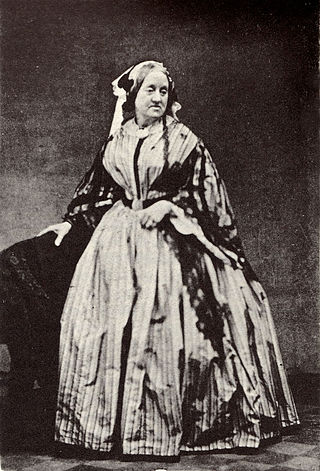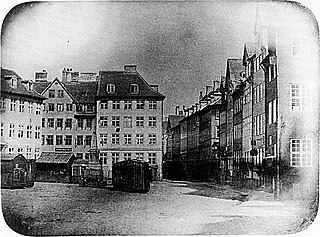Related Research Articles

Ansel Easton Adams was an American landscape photographer and environmentalist known for his black-and-white images of the American West. He helped found Group f/64, an association of photographers advocating "pure" photography which favored sharp focus and the use of the full tonal range of a photograph. He and Fred Archer developed a system of image-making called the Zone System, a method of achieving a desired final print through a technical understanding of how the tonal range of an image is the result of choices made in exposure, negative development, and printing.

Imogen Cunningham was an American photographer known for her botanical photography, nudes, and industrial landscapes. Cunningham was a member of the California-based Group f/64, known for its dedication to the sharp-focus rendition of simple subjects.

George Washington Wilson was a pioneering Scottish photographer. In 1849, he began a career as a portrait miniaturist, switching to portrait photography in 1852. He received a contract to photograph the Royal Family, working for Queen Victoria and Prince Albert. He pioneered various techniques for outdoor photography and the mass production of photographic prints as he gradually began to largely do landscape photography in the 1860s. By 1864 he claimed to have sold over half a million copies.

Roger Fenton was a British photographer, noted as one of the first war photographers.

Street photography is photography conducted for art or inquiry that features unmediated chance encounters and random incidents within public places, usually with the aim of capturing images at a decisive or poignant moment by careful framing and timing. Although there is a difference between street and candid photography, it is usually subtle with most street photography being candid in nature and some candid photography being classifiable as street photography. Street photography does not necessitate the presence of a street or even the urban environment. Though people usually feature directly, street photography might be absent of people and can be of an object or environment where the image projects a decidedly human character in facsimile or aesthetic.

Samuel Bourne was a British photographer known for his prolific seven years' work in India, from 1863 to 1870. Together with Charles Shepherd, he set up Bourne & Shepherd first in Shimla in 1863 and later in Kolkata (Calcutta); the company closed in June 2016.

War photography involves photographing armed conflict and its effects on people and places. Photographers who participate in this genre may find themselves placed in harm's way, and are sometimes killed trying to get their pictures out of the war arena.

Eliot Furness Porter was an American photographer best known for his color photographs of nature.

Anna Atkins was an English botanist and photographer. She is often considered the first person to publish a book illustrated with photographic images. Some sources say that she was the first woman to create a photograph.
John Stathatos, Greek photographer and writer.

Nature photography is a wide range of photography taken outdoors and devoted to displaying natural elements such as landscapes, wildlife, plants, and close-ups of natural scenes and textures. Nature photography tends to put a stronger emphasis on the aesthetic value of the photo than other photography genres, such as photojournalism and documentary photography.
Marie Cosindas was an American photographer. She was best known for her evocative still lifes and color portraits. Her use of color photography in her work distinguished her from other photographers in the 1960s and 1970s. Most of her photographs were portraits and pictures of objects like dolls, flowers, and masks.

In Denmark, photography has developed from strong participation and interest in the very beginnings of the art in 1839 to the success of a considerable number of Danes in the world of photography today.
History of Greek photography from its beginning to the present

The participation of women in photography goes back to the very origins of the process. Several of the earliest women photographers, most of whom were from Britain or France, were married to male pioneers or had close relationships with their families. It was above all in northern Europe that women first entered the business of photography, opening studios in Denmark, France, Germany, and Sweden from the 1840s, while it was in Britain that women from well-to-do families developed photography as an art in the late 1850s. Not until the 1890s, did the first studios run by women open in New York City.

Mary Alison Frantz was an American archaeological photographer and a Byzantine scholar. She is best known for her work as the official photographer of the excavations of the Agora of Athens, and for her photographs of ancient Greek sculpture, including the Parthenon frieze and works from the Temple of Zeus at Olympia.

John Chester Cato was an Australian photographer and teacher. Cato started his career as a commercial photographer and later moved towards fine-art photography and education. Cato spent most of his life in Melbourne, Australia.
Voula Papaïoannou (1898–1990) was a Greek photographer, known for her photography of Greece, its people and its landscape.

Photographs have been taken in the area now known as Canada since 1839, by both amateurs and professionals. In the 19th century, commercial photography focussed on portraiture. But professional photographers were also involved in political and anthropological projects: they were brought along on expeditions to Western Canada and were engaged to document Indigenous peoples in Canada by government agencies.
References
- 1 2 3 4 Stathatos, John (9 January 2011). "Photographers > Mary Paraskeva". Luminous-Lint . Archived from the original on 1 July 2022. Retrieved 12 March 2013.
- ↑ Stathatos, John (16 July 1999). "New Books on Greek Photography [First published as 'Pioneers of National Pride']". Times Literary Supplement . Archived from the original on 28 November 2012. Retrieved 12 March 2013– via stathatos.net.
- ↑ Lenman, Robin (2008). "Mary Paraskeva". Oxford Companion to the Photograph. Oxford University Press. ISBN 9780199551989. OCLC 231883615. Archived from the original on 9 March 2008. Retrieved 12 March 2013– via answers.com.
- ↑ Stathatos, John (2000). "A Conditional Presence: Women landscape photographers in Europe". In Wells, Liz; Newton, Kate; Fehily, Catherine (eds.). Shifting Horizons: Women’s Landscape Photography Now. I. B. Tauris. ISBN 9781860646355. OCLC 47163149. Archived from the original on 27 September 2023. Retrieved 22 January 2024– via stathatos.net.